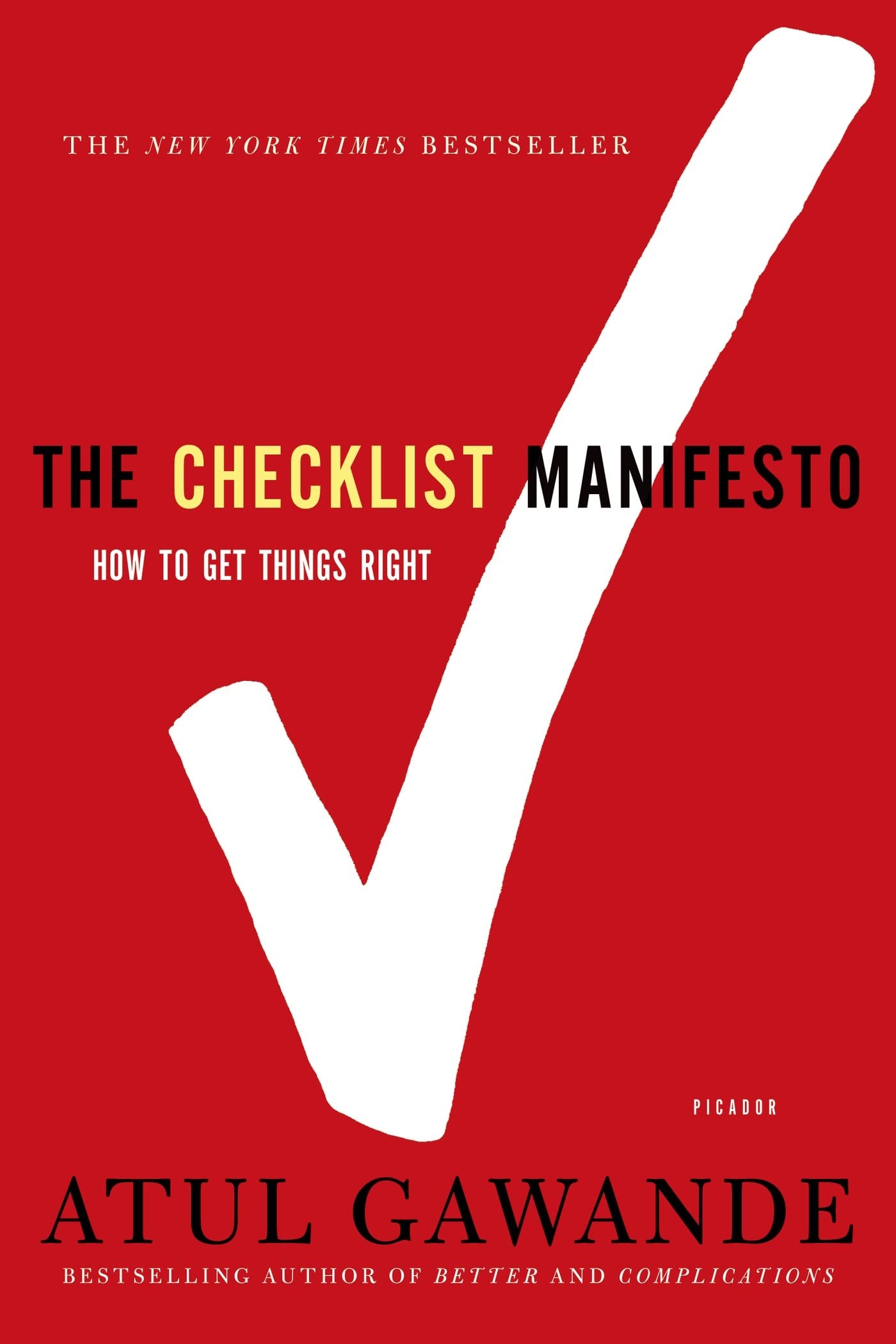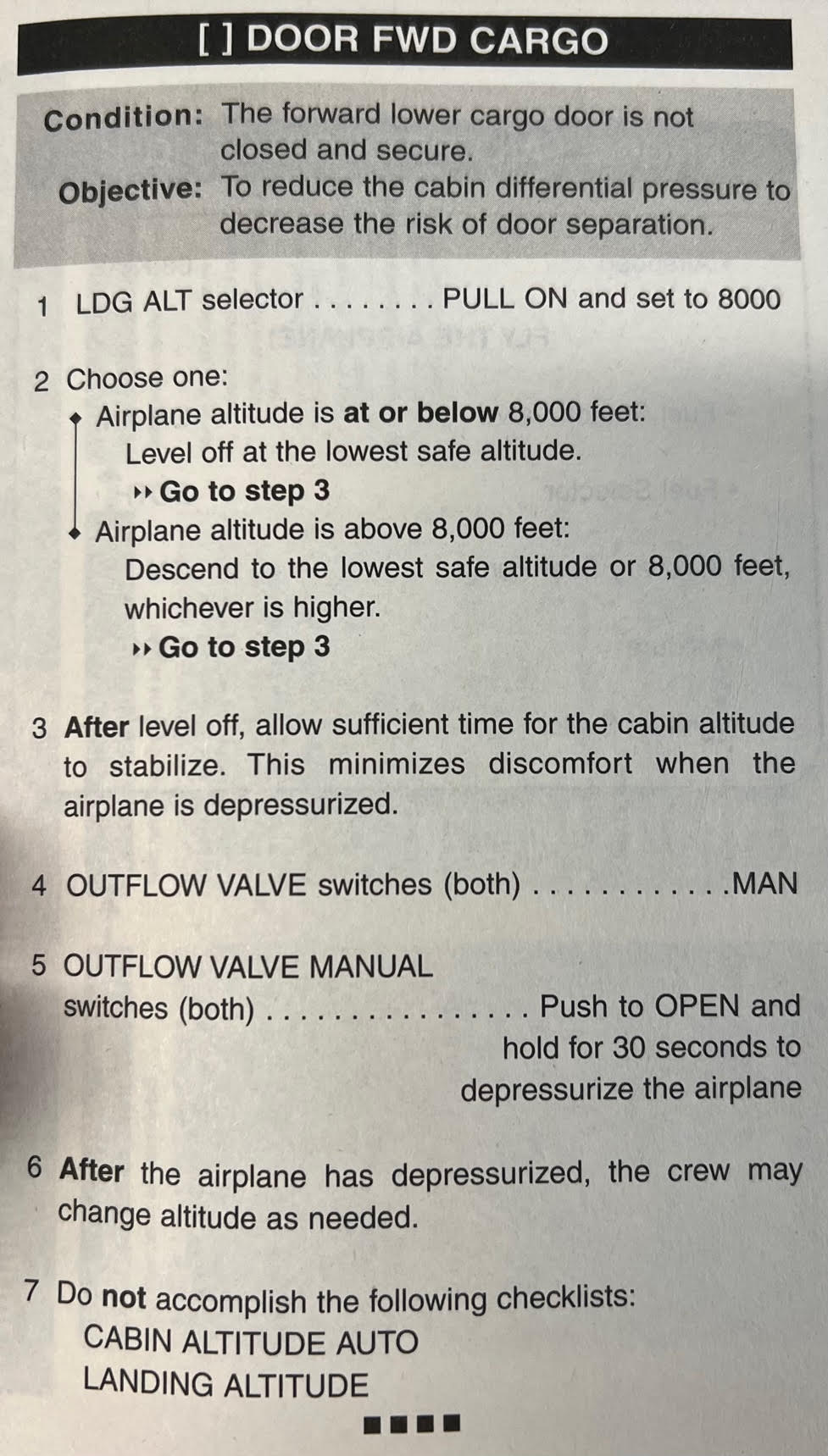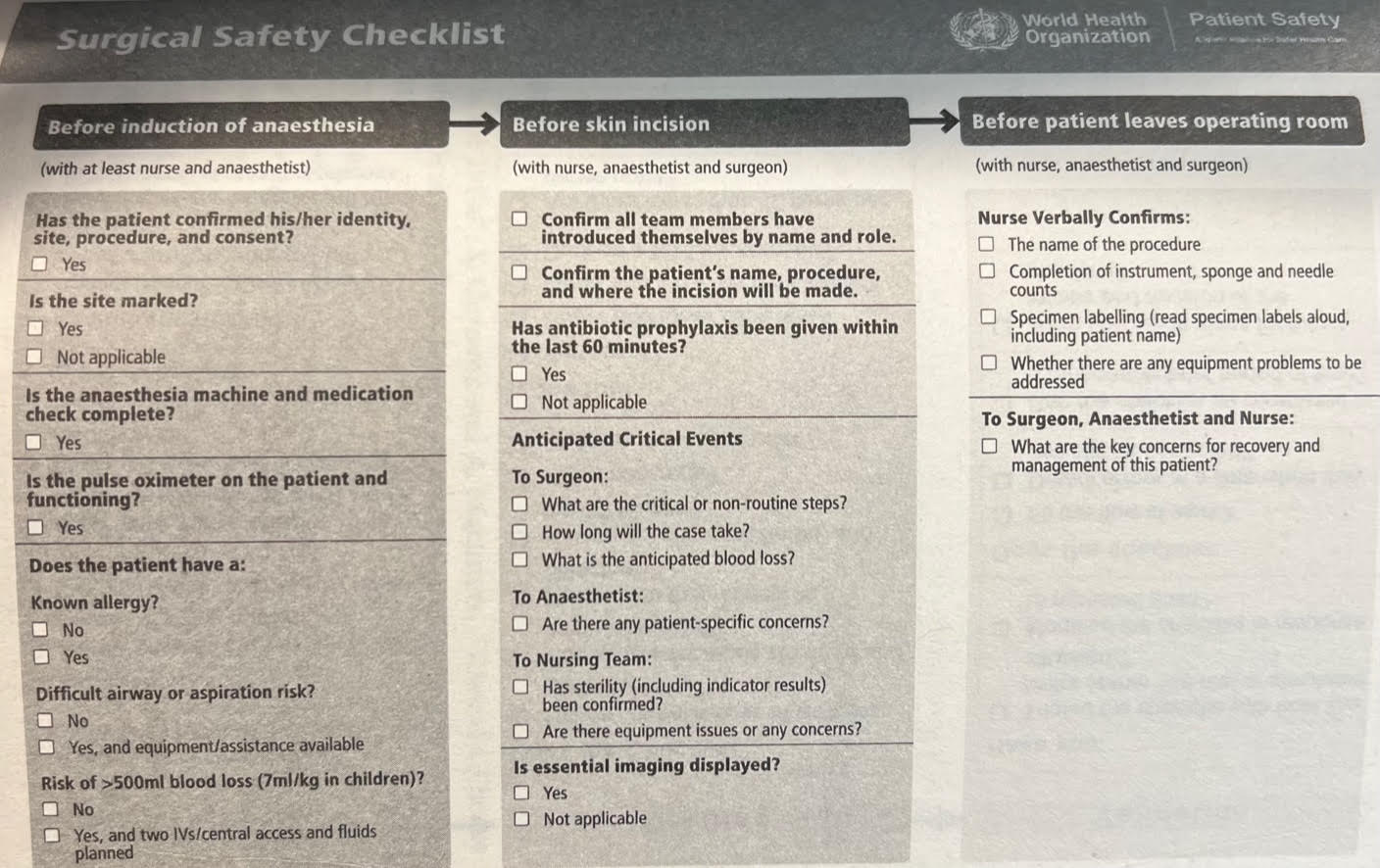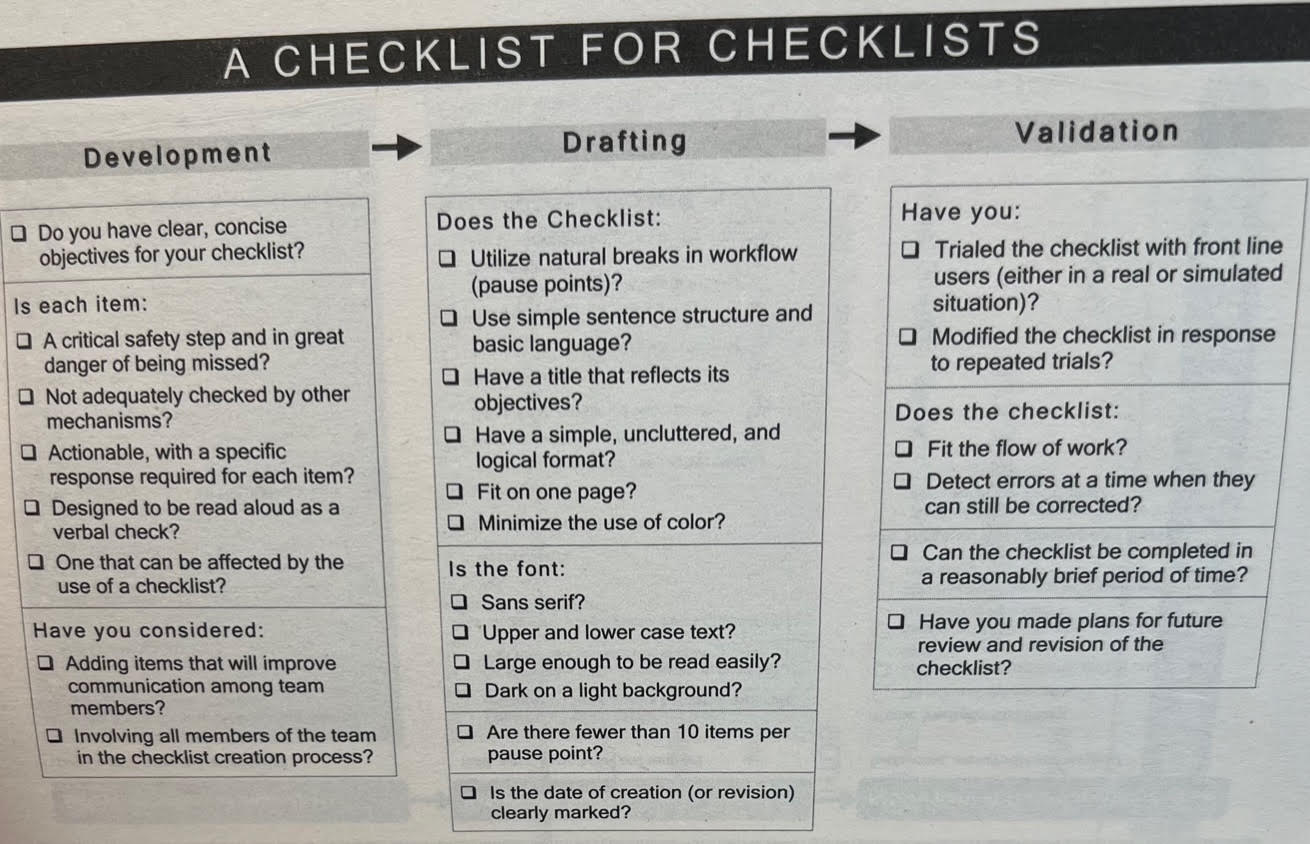
The Checklist Manifesto
Atul Gawande
 GENRE: Miscellaneous
GENRE: Miscellaneous
 PAGES: 240
PAGES: 240
 COMPLETED: September 22, 2022
COMPLETED: September 22, 2022
 RATING:
RATING: 




Short Summary
In his latest bestseller, Atul Gawande explains the surprising power of simple checklists using stories from health care, government, and the financial industry. The Checklist Manifesto explores the value of checklists in today’s complex, fast-paced world.
Key Takeaways



Favorite Quote
“Even the most expert among us can gain from searching out the patterns of mistakes and failures and putting a few checks in place.”
Book Notes 
Introduction
- Atul Gawande — The author of this book, Gawande is a general and endocrine surgeon at the Brigham and Women’s hospital in Boston, a staff writer for The New Yorker, and a professor at Harvard Medical School. He is also a big proponent of the checklist, and that’s what this book is about.
- Interesting Fact — Too much potassium can stop the heart — that’s how states execute prisoners sentenced to the death penalty. Severely low potassium levels can also stop the heart, to which a corrective dose of potassium will fix it.
- Interesting Fact — Even as recently as the 1950s, we didn’t know much about heart attacks and how to prevent or treat them. We didn’t know about the dangers of high blood pressure, cholesterol, smoking, or diabetes. The first safe medication to treat hypertension was not developed and conclusively shown to prevent disease until the 1960s. Now, we’ve got a ton of ways to prevent and treat heart attacks.
- Quote (P. 13): “One needs practice to achieve mastery, a body of experience before one achieves real success. And if what we are missing when we fail is individual skill, then what is needed is simply more training and practice.”
- Takeaway — Practice, experience, and knowledge are a few of the key ingredients to success.
Ch. 1: The Problem of Extreme Complexity
- Interesting Fact — Alexander Fleming discovered this antibiotic penicillin in 1928 in London. When it was discovered, penicillin proved to be a game-changer. It is extremely effective against a large number of infectious diseases that were previously untreatable.
- Intensive Care Unit (ICU) — An ICU is the critical care unit of a hospital. With all of the technology and other capabilities we have available today, ICUs allow doctors to basically take artificial control of failing bodies. As a result, we’re able to survive certain health issues that we previously had no chance of surviving. Over 5 million people are admitted to the ICU every year, and the average patient requires over 170 individual actions every day.
- Line Infections — With all of the lines and tubes that doctors stick into people who are in the ICU, one of the biggest issues is contaminated lines, which can lead to serious infections. Studies have found that ICUs put 5 million lines into patients every year, and 4% of those lines become infected after 10 days. Line infections occur in 80,000 people every year and are fatal between 5-28% of the time.
Ch. 2: The Checklist
- Boeing B-17 — In 1935, the U.S. Army was looking for its newest long-range bomber. The Boeing Model 299 was the clear frontrunner; it could carry five times as many bombs as the Army asked for, and it could fly twice as fast and far as previous bombers. But during an early test run, the plane crashed in front of a small crowd of Army leadership, killing two of the five members on board. ‘Pilot error’ was the reason for the crash — the pilot had forgotten one of the steps while operating the complex aircraft.
- The Checklist — The Model 299 was the most complex airplane ever made and required extreme attention to detail while in the air. Following the crash, Army pilots made a checklist to use while operating the plane. It worked wonders — the pilots went on to fly the plane almost 2 million times without a crash. The Army ordered 13,000 of the Model 299, which it later called the B-17. Because it was now operable using a checklist, the B-17 gave the U.S. military a big air advantage in its bombing campaign across Nazi Germany in World War II.
- Checklists at Johns Hopkins — In 2001, a doctor at Johns Hopkins Hospital named Peter Pronovost developed a checklist designed to prevent line infections. The checklist outlined all of the basic steps involved with correctly inserting a line in a patient. He first tested the checklist’s viability at his own hospital before taking the idea further. It was a huge success at John’s Hopkins: the ten-day line-infection rate went from 11% to 0%.
- Quote (P. 39): “The researchers found that simply having the doctors and nurses in the ICU create their own checklist for what they thought should be done each day improved the consistency of care to the point that the average length of patient stay in intensive care dropped by half.”
- Quote (P. 39): “These checklists accomplished what checklists everywhere have done. They helped with memory recall and clearly set out the minimum necessary steps in the process.”
- The Keystone Initiative — Following the success at Johns Hopkins, Pronovost took his checklist program to the next level. In what became known as the Keystone Initiative, hospitals in Michigan were assigned a project manager to roll out the checklist.
- Results — Within the first three months of the project, the line infection rate in Michigan’s ICUs decreased by 66%. Michigan’s infection rates fell so low that its average ICU outperformed 90% of ICUs nationwide. In the Keystone Initiative’s first 18 months, the hospitals saved an estimated $175 million in costs and more than 1,500 lives.
Ch. 3: The End of the Master Builder
- Quote (P. 57): “A building is like a body. It has a skin. It has a skeleton. It has a vascular system — the plumbing. It has a breathing system — the ventilation. It has a nervous system — the wiring. Altogether, projects today involve some 16 different trades.”
- Building Towers — One of the most complex projects anybody can take on is designing and building a tower. In addition to his field of medicine, Gawande also found that architects and building companies use simple checklists to manage the thousands of things that need to get done when building a tower. Just as in medicine, following the proper process is crucial — one forgotten missed step can throw off the sequencing of steps and cause major issues.
- Russia Wharf — A 32-story, 700,000 square-foot office and apartment complex in downtown Boston along the water. Gawande visited the construction site as the tower was being built and saw several different checklists hanging in the project’s field office. The checklists were designed to keep everybody on track and on the same page.
- Quote (P. 62): “What results is remarkable: a succession of day-by-day checks that guide how the building is constructed and ensure that the knowledge of hundreds, perhaps thousands, is put to use in the right place at the right time in the right way.”
- Takeaway — This is why checklists are so effective. Our working memory is limited and distractions in our lives pop up. Written checklists help you manage and execute simple, difficult, and complex projects at a high level. They help you stay on track by keeping you organized so you can hit every step in the process. Be detailed with your checklists and throw in dates that outline when things need to be done.
- Interesting Fact — As towers are being built, the crew has to fireproof the metal being used. In a fire, metal can plasticize — lose its stiffness and bend like spaghetti. This is one of the reasons the World Trade Center buildings collapsed.
Ch. 4: The Idea
- Quote (P. 72): “In response to risk, most authorities tend to centralize power and decision making. That’s usually what checklists are about — dictating instructions to the workers below to ensure that they do things the way we want. Indeed, the first building checklist I saw, the construction schedule on the right hand wall of O’Sullivan’s conference room, was exactly that. It’s spelled out to the tiniest detail every critical step the tradesmen were expected to follow and when — which is logical if you’re confronted with simple and routine problems; you want the forcing function.”
- Takeaway — If you’re in a leadership position, checklists are a great way to ensure everyone in the organization completes tasks the way you want them done. Outline the process by developing a detailed checklist and distribute it to employees. McDonald’s does this; there are checklists for everything: making burgers, shakes, cleanup, etc.
- Wal-Mart & Hurricane Katrina — While the U.S. government struggled to take proper action when Hurricane Katrina hit New Orleans in August 2005, Wal-Mart was on top of things. By the end of the crisis, Walmart had sent in a total of 2,498 trailer loads of emergency supplies and donated $3.5 million in merchandise to area shelters and command centers.
- Trust & Leadership — The reason Wal-Mart thrived and the government did not was that Wal-Mart allowed store managers and employees to make decisions on their own with the information they had. Upper management trusted their employees and gave them the freedom to make decisions. The government did not — decisions were slow to be made because every little thing had to run through a small group of people.
- Quote (P. 79): “The real lesson is that under conditions of true complexity — where the knowledge required exceeds that of any individual — efforts to dictate every step from the center will fail. People need room to act and adapt. Yet they cannot succeed as isolated individuals, either — that is anarchy. Instead, they require a seemingly contradictory mix of freedom and expectation — expectation to coordinate, for example, and also to measure progress toward common goals.”
- Takeaway — There’s an important lesson about leadership in this story. Too many companies, departments, and teams lack trust in their people. When every decision or piece of work has to be reviewed and approved by leadership, it takes forever to get anything done and employee morale takes a hit. The people in leadership positions may not even have the requisite knowledge or skill to make the right decision. If ever in a position of leadership, trust your people. Allow them the freedom to make decisions, trust their work, and embrace risk-taking, even if it doesn’t always work out.
- Quote (P. 79): “The real lesson is that under conditions of true complexity — where the knowledge required exceeds that of any individual — efforts to dictate every step from the center will fail. People need room to act and adapt. Yet they cannot succeed as isolated individuals, either — that is anarchy. Instead, they require a seemingly contradictory mix of freedom and expectation — expectation to coordinate, for example, and also to measure progress toward common goals.”
- Trust & Leadership — The reason Wal-Mart thrived and the government did not was that Wal-Mart allowed store managers and employees to make decisions on their own with the information they had. Upper management trusted their employees and gave them the freedom to make decisions. The government did not — decisions were slow to be made because every little thing had to run through a small group of people.
- Quote (P. 79): “I came away from Katrina and the builders with a kind of theory: under conditions of complexity, not only are checklists a help, they are required for success. There must always be room for judgment, but judgment aided — and even enhanced — by procedure.”
- Takeaway — Checklists are essential for managing and executing any task at a high level. There should always be room for judgement calls, but there needs to be a clearly defined process to minimize mistakes and ensure that little stuff isn’t missed, and detailed checklists accomplish that.
- Interesting Fact — In every one of its contracts with promoters, the famous rock band Van Halen required that a bowl of M&Ms was available backstage, and brown M&Ms had to be removed from the dish. If brown M&Ms were found, the concert was cancelled. The M&M clause was ultimately part of their checklist; if the people operating the concert got that wrong, there was a good chance they didn’t fully read the contract and there was likely a technical error somewhere else that could compromise the quality of the concert. Van Halen actually cancelled a concert in Colorado for this reason. Brown M&Ms were found, so they checked the rest of the production and discovered that their stage equipment would have fallen through the arena floor because the local promoters didn’t read the weight requirements.
Ch. 5: The First Try
- Anesthesia — Considered the riskiest part of a surgery. A treatment using drugs called anesthetics. These drugs keep you from feeling pain during medical procedures. There are three different types:
- Local Anesthesia — This treatment numbs a small section of the body.
- Regional Anesthesia — Regional anesthesia blocks pain in a larger part of your body, such as a limb or everything below your chest.
- General Anesthesia — This treatment makes you unconscious and insensitive to pain. General anesthesia is used for more invasive surgical procedures, or procedures of the head, chest, or abdomen.
- ‘Cleared for Takeoff’ Checklist — Columbus Children’s Hospital in Ohio uses a ‘Cleared for Takeoff’ checklist to combat the issue of poorly timed antibiotic delivery. In 2005, the hospital found that more than one-third of its appendectomy patients failed to get the right antibiotic at the right time. Some got it too soon. Some got it too late. Some didn’t get it at all. The checklist was put on the white board in every operating room to ensure nurses and doctors gave the antibiotic exactly 60 minute later for an incision was to be made.
- Results — After 8 months, the hospital found that 100% of appendectomy patients received their antibiotic on time. The checklist had worked.
Ch. 6: The Checklist Factory
- Interesting Fact — When in an airplane soaring at 30,000 feet, you would not be able to breathe without the cabin being pressurized. At that altitude, if a cargo door blew off, the difference in pressure between the cabin and the air outside would cause major issues. This happened on a 1989 United Airlines flight from Honolulu, Hawaii to New Zealand. A cargo door blew off and nine passengers flew out into the ocean. The pilot ultimately landed the plane safely after that, but it was a nearly a major tragedy. The right thing to do in that situation is to lower the plane’s elevation to 8,000 feet (the altitude in Aspen, Colorado) and release depressurize the cabin. At that elevation, people can still breathe somewhat comfortably.
- Boeing Checklists — Pilots use many checklists during the course of a flight. Boeing issues over 100 checklists, either new or revised, every year. Each one is carefully designed and tailored for different situations a pilot might encounter, including potential disasters. Pilots are taught in flight school to turn to the checklists and avoid using instincts. In the 1989 United Airlines flight, the voice box captured the pilot going through his checklist.
- Quote (P. 120): “There are good checklists and bad. Bad checklists are vague and imprecise. They are too long; they are hard to use; they are impractical.”
- Quote (P. 120): “Good checklists, on the other hand, are precise. They are efficient, to the point, and easy to use even in the most difficult situations. They do not try to spell out everything — a checklist cannot fly a plane. Instead, they provide reminders of only the most critical and important steps — the ones that even the highly skilled professionals using them could miss.”
- Creating a Checklist — There are a couple of general guidelines to follow when creating a checklist. A few of these include:
- Type of List — There are two basic types of checklists pilots and people in medicine use:
- DO-CONFIRM — Team members perform their jobs from memory and experience, but then they stop to run through the checklist and make sure everything was done.
- READ-DO — Essentially a walkthrough tutorial. You look at each check, perform the task, mark it, and move on.
- ‘Killer Items’ — Only include the key steps. Keep the checklist between 5-9 steps as this is the limit of working memory. The checklist isn’t meant to be a manual — focus on the essential steps.
- Keep It Simple — You don’t need to go into extreme detail in every step. Keep the wording simple and exact.
- Look and Feel — The checklist should fit on one page. Write each step in large font. Use color coding if you want. Make it pop.
- Type of List — There are two basic types of checklists pilots and people in medicine use:
- Quote (P. 128): “It is common to misconceive how checklists function in complex lines of work. They are not comprehensive how-to guides, whether for building a skyscraper or getting a plane out of trouble. They are quick and simple tools aimed to buttress the skills of expert professionals. And by remaining swift and usable and resolutely modest, they are saving thousands upon thousands of lives.”
- Takeaway — Checklists shouldn’t outline every little thing in the process. The goal is to get all of the key steps on paper so nothing is skipped over and dumb mistakes are avoided. Don’t go overboard by writing too many details in the checklist.
- Interesting Fact — Commercial planes began flying “polar routes” in 2001. Pilots have to carefully monitor the fuel because it can freeze when flying in severely low temperatures. The freezing point for Jet A-1 fuel is -53 degrees, but polar routes can take planes into temperatures far colder than that. There’s a checklist for dealing with complications from frozen fuel.
Ch. 7: The Test
- WHO Safe Surgery Checklist — In 2007, Gawande was recruited by the World Health Organization (WHO) to help the organization create a safe surgery checklist designed to reduce the number of deaths and disabilities caused by complications from surgery. The checklist had 19 steps in total and was initially tested in eight hospitals around the world.
- Results — After three months of testing in the real world, the returning evidence was conclusive: the checklist worked. Deaths fell 47%. Infections fell by almost half. In every hospital, introduction of the checklist had been accompanied by a big reduction in complications. In seven out of the eight, it was a double-digit percentage drop.
Ch. 8: The Hero in the Age of Checklists
- Quote (P. 158): “Even the most expert among us can gain from searching out the patterns of mistakes and failures and putting a few checks in place.”
- Takeaway — We can all benefit from a checklist. It can keep us organized and on track. Strong checklists can be a crutch to lean on when completing simple or complex projects. They can be a safety blanket to refer back to.
- Interesting Fact — Neuroscientists have found that the prospect of making money stimulates the same primitive reward circuits in the brain that cocaine does. Thinking about money is called “cocaine brain.”
- Miracle on the Hudson — On January 15, 2009, US Airways Flight 1549 took off from La Guardia Airport in New York City with 155 people on board, struck a large flock of Canada geese over Manhattan, lost both engines, and crash-landed in the nearby Hudson River. The plane was piloted by 57 year-old Captain Chelsey B. “Sully” Sullenberger III. Everybody survived.
- Sully & Checklists — Checklists are used a ton in the aviation industry. Sully and his co-pilot used the book of checklists in the cockpit to run through the pre-flight routine and help land the plane. The co-pilot attempted to reignite the engines using one of the checklists. Both pilots used the checklist book to quickly and successfully evacuate the plane once it had landed in the river.
- Canadian Geese — Planes are built to handle bird strikes. Hundreds of thousands of birds have been hit by planes without issue. But Canadian geese are different — they are normally big birds that weigh more than 10 pounds. Hitting one of these birds is rare. Hitting three of them, as Sully’s plane did, is really rare. When Canadian geese hit a plane’s engine, the engine normally shuts down.
- Quote (P. 183): “Discipline is hard — harder than trustworthiness and skill and perhaps even than selflessness. We are by nature flawed and inconstant creatures. We can’t even keep from snacking between meals. We are not built for discipline. We are built for novelty and excitement, not for careful attention to detail. Discipline is something we have to work at.”
- Takeaway — It takes effort to be disciplined. It doesn’t come easily to us. We’re built to take the easy way. Checklists can help you stay disciplined, but it ultimately takes a lot of work on our end to commit to discipline. The rewards for being displayed are huge though.
Appendix: Example Checklists




